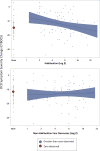Measuring fear change within exposures: Functionally-defined habituation predicts outcome in three randomized controlled trials for pediatric OCD
- PMID: 29939055
- PMCID: PMC6023553
- DOI: 10.1037/ccp0000315
Measuring fear change within exposures: Functionally-defined habituation predicts outcome in three randomized controlled trials for pediatric OCD
Abstract
Objective: This study measured a variety of within-exposure fear changes and tested the relationship of each with treatment outcomes in exposure therapy.
Method: We coded 459 videotaped exposure tasks from 111 participants in 3 clinical trials for pediatric obsessive-compulsive disorder (OCD; POTS trials). Within exposures, fear level was observed continuously and alongside exposure process. Fear change metrics of interest were selected for relevance to mechanistic theory. Fear decreases were classified by function; nonhabituation decreases were associated with observed nonlearning processes (e.g., avoidance), whereas habituation decreases appeared to result from an internal and indirect process. Outcomes were posttreatment change in symptom severity, global improvement, and treatment response.
Results: Greater cumulative habituation across treatment was associated with larger reductions in symptom severity, greater global improvement, and increased odds of treatment response. Fear activation, fear variability, and nonhabituation fear decreases did not predict any outcomes. Exploratory analyses examined fear changes during habituation and nonhabituation exposures; higher peak fear during nonhabituation exposures was associated with attenuated global improvement.
Conclusions: Habituation is conceptually consistent with multiple mechanistic theories and should continue to be investigated as a practical marker of initial extinction learning and possible moderator of the relationship between fear activation and outcome. Results support the importance of functional and frequent fear measurement during exposures, and discussion considers implications of these findings for future studies aiming to understand learning during exposure and improve exposure delivery. (PsycINFO Database Record
(c) 2018 APA, all rights reserved).
Figures





References
-
- Abramowitz JS, Arch JJ. Strategies for Improving Long-Term Outcomes in Cognitive Behavioral Therapy for Obsessive-Compulsive Disorder: Insights From Learning Theory. Cognitive and Behavioral Practice. 2014;27(1):20–31.
-
- Ale CM, McCarthy DM, Rothschild LM, Whiteside SPH. Components of Cognitive Behavioral Therapy Related to Outcome in Childhood Anxiety Disorders. Clinical Child and Family Psychology Review. 2015;75(3):240–251. - PubMed
-
- Beidas RS, Barmish AJ, Kendall PC. Training as usual: Can therapist behavior change after reading a manual and attending a brief workshop on cognitive behavioral therapy for youth anxiety? The Behavior Therapist / AABT. 2009;32(5):97.
-
- Chorpita BF, Daleiden EL. Mapping evidence-based treatments for children and adolescents: application of the distillation and matching model to 615 treatments from 322 randomized trials. Journal of Consulting and Clinical Psychology. 2009;77(3):566–579. - PubMed
Publication types
MeSH terms
Grants and funding
LinkOut - more resources
Full Text Sources
Other Literature Sources
Medical

